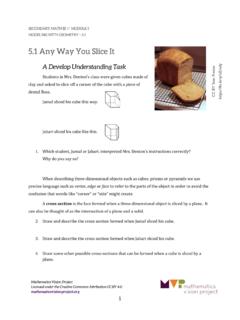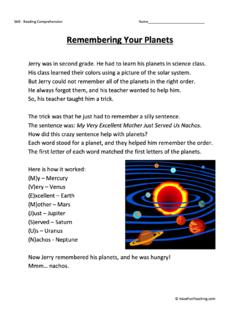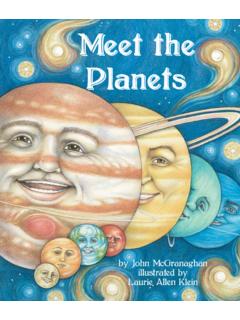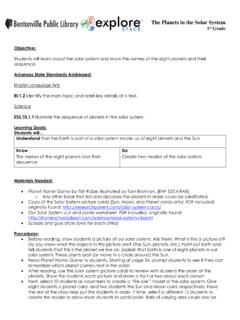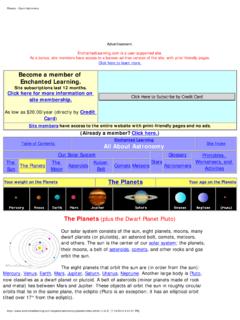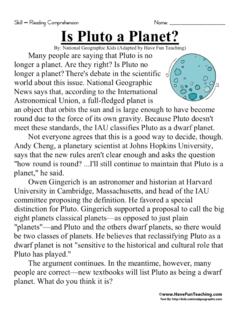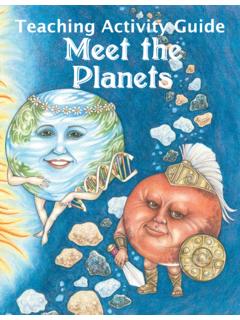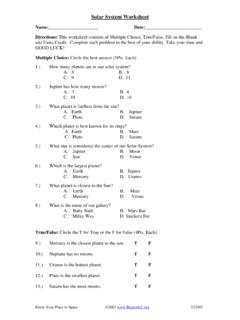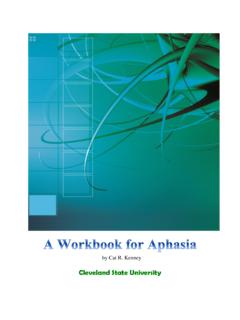Transcription of Astronomy D. They are very large and made of gases. 2. A ...
1 6 Standard 3 Unit Test A AstronomyMultiple Choice1. The four inner planets are rocky and small. Which description best fits the next four outer planets? A. They are also rocky and small. B. They are very large and made of ice. C. They are small and made of ice. D. They are very large and made of Which two planets are out of order in this list of our solar system? The planets are listed in order of distance from the A. Mercury and Earth B. Earth and Venus C. saturn and Jupiter D. Uranus and Neptune3. What is a special characteristic of Jupiter, saturn , Neptune and Uranus?
2 A. They are planets in our solar system. B. They spin slowly. C. They revolve around the sun. D. They have How does a telescope help us understand the moon? A. It tells us how it was formed. B. It tells us how hot it is there. C. It helps us see surface features. D. It can tell us what the moon is made A probe landed on Mars and did soil tests. What information did it discover? A. There are no living organisms in Martian soil. B. Mars is slightly oval in shape. C. Mars is about one-fourth the size of Earth. D. The gravity on Mars is much less than on Pictures from space are sent to Earth.
3 How are they printed? A. On paper from film sent from the probe. B. A computer reads a code and places dots on paper. C. They are drawn by hand as the information is received. D. They are sent through space by rockets and are already Why is space travel difficult for people? A. We cannot take the air or food we need into space. B. The distances are very great; it is dangerous and expensive. C. It is impossible to escape the sun s or Earth s gravity. D. We do not have a destination to visit that we know will support What holds the planets in their orbits around the sun? A. gravity B. speed C.
4 String D. air currents9. Which object has the most gravity? A. Earth B. moon C. Jupiter D. sun10. Without gravity, what would be the shape of the solar system? A. Planets would revolve in perfect circles. B. Much different than it is now. C. Planet s orbits would cross. D. All planets would be in the same Response1. What is the difference between an asteroid and a meteor? 2. How do we know about outer space, beyond our solar system?3. How are the orbits of Earth around the sun and the orbit of the moon around Earth alike? Standard 3-unit test A:Multiple Choice1. D2. B3. D4. C5. A6. B7.
5 B8. A9. D10. BConstructed Response1. Asteroids are chunks of rock in orbit around the sun, meteors are chunks of rock that fall through Earth s From information gathered through Both rely on the greater gravitational pull of the more massive object and their own for-ward motion to match and keep them in 6 Standard 3 Unit Test B AstronomyMultiple Choice1. What do planets revolve around? A. each other B. a star or sun C. a moon D. a galaxy2. If you could live on Jupiter, what would you see in the sky at night besides stars? A. many moons B.
6 The inner planets C. the sun D. Earth s moon3. Which two planets are out of order in this list of our solar system? The planets are listed in order as they go out from the A. Mercury and Earth B. Earth and Venus C. saturn and Jupiter D. Neptune and Pluto4. Mary looked in her science book at a picture of the solar system. The planets were large and colorful, but she knew it was not an accurate model. Why? A. The planets should have been much farther apart. B. The planets are not colorful. They are white. C. We don t know exactly what the planets look like, so it was a guess. D. Planets are oval and not What is an important function of space probes, such as Voyager, as they travel in space?
7 A. to land on each planet and report the conditions there B. to take pictures and send them back to Earth C. to see if other stars have planets D. to see if life exists on other planets6. What have probes orbiting on Venus recently discovered? A. The atmosphere appears white. B. It is the third planet from the sun. C. There are volcanoes on its surface. D. Venus is larger than Which of the following instruments could best see the rings on saturn ? A. your eye B. binoculars C. a telescope D. a magnifying glass8. Some objects are invisible in space yet astronomers know they exist. On what do they base their knowledge?
8 A. They give off radio or X-rays that we can analyze. B. They were once visible and people recorded it. C. Astronomers have a sixth sense that helps them know. D. Telescopes can see things that people What would happen to Earth if it started going faster around the sun? A. It would fall into the sun. B. It would travel away from the sun. C. Its gravity would decrease. D. Its gravity would What do objects that have more mass also have more of? A. volume B. size C. gravity D. speedConstructed Response1. How is a planet different from a star?2. Pick a planet (other than Earth) and describe 5 characteristics that you know about it.
9 Be as specific as Space probes have not landed on Pluto yet. Describe three types of information you would collect if you were designing the probe. Tell what you think the results of each test might How have computers aided our understanding of space?5. How is spinning a weight tied to a string around your head similar to the orbit of a planet around the sun? Standard 3-unit test B:Multiple B2. A3. D4. A5. B6. C7. C8. A9. B10. CConstructed Response1. Planets are smaller than stars and are not glowing producing their own Students should have 5 correct characteristics of the planet they Students may mention temperatures, movement of crust, composition of crust, type of atmosphere, gravity, presence of life etc.
10 The results of these tests would indicate that Pluto is very cold, mostly ice, little or no atmosphere, small gravity and no They are able to take large amounts of data and process it The spinning speed is the same as the velocity of a moving planet, the string is like gravity holding it in 6 Standard 3 Performance Test 1 AstronomyTitle: TelemetryActivity Description: Students will send a message to a partner who willdecode it similar to real space Needed: grid sheet, pictures of simple objects Prior to Assessment: Students should know that messages travelingthrough space must be sent via electromagnetic rays such as light or radiowaves.



